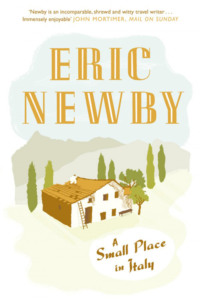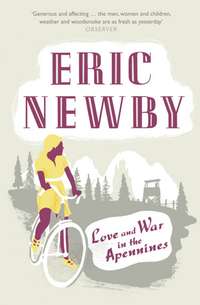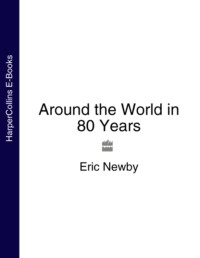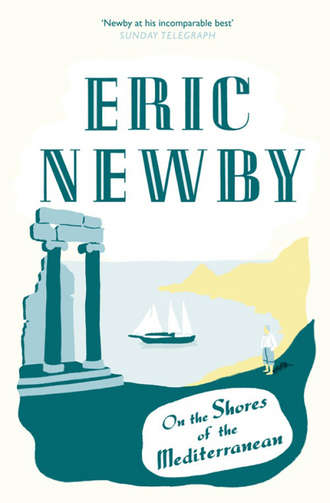
Полная версия
On the Shores of the Mediterranean
A rather unusual lake, the Cerkniško Jezero, normally a sheet of water seven miles long and six feet deep, at certain seasons, of which this was one, disappears without warning, together with its inhabitants which include fish with horns and a freshwater jellyfish. Besides these fishy inhabitants, and in winter enormous numbers of waterfowl, it also has a ghostly population of skeleton warriors armed with lances and axes and mounted on skeleton horses. From time to time they rise from beneath the surface and, preceded by flocks of skeletal birds, circuit the lake making the night hideous with the clattering of their bones and weapons.
At Planina, the Pivka, another underground river, emerges in a deep valley, having been joined, also underground, by the Rak, a river which has its origins beneath the Cerkniško Jezero. In the valley at Planina the now-augmented Pivka is joined by a third river which also emerges from underground at this point, the Malenska, after which, still called the Pivka, it flows through watermeadows of extraordinary beauty until, eventually, it sinks for what is the last time in its career beneath the Ljubljanski Mountain near Ljubljana, beyond which it joins the Sava and eventually the Danube, flowing with it into the Black Sea.
Across the river from Planina, standing on the edge of the forest from which the red deer come down into the park from the Javornik, is the Haasberg, a castle, a country house really, of the Princes of Windisch-Graetz, a family reputed to have owned ninety-nine castles in Austria-Hungary before 1914, a figure that makes one suspect that this is legend because anyone having ninety-nine castles could surely not have resisted the temptation to acquire one more and make it a round hundred. Nevertheless, when the Italians annexed a large slice of what had been until 1918 Slovene territory in Austria-Hungary, the Windisch-Graetz still had sufficient influence to have the new frontier moved sufficiently far to the east, a matter of yards, for the house itself to be on Italian soil. The stones marking the boundaries can still be seen in the park behind the house.
The Haasberg was burned by the Yugoslav partisans in 1944 when it was an Italian headquarters. Now it is an empty shell. The watermills that stand one above the other in the valley of the Malenska are ruined; the church in the park unused, occupied by thirteen members of the family lying in stone sarcophagi. (The fourteenth sarcophagus lies empty with its lid drawn to one side, waiting for an occupant who will now, presumably, never come.) Very old retainers, one of whom was pottering about the dilapidated barns and outbuildings in a battered green hat, recall what to them was a happier age before the Second World War.
Whatever the Carso or the Kras may be, this sad and beautiful place has nothing at all to do with the Mediterranean and never has done. Here, if anywhere, you can say that the Mediterranean world ends and that of Middle Europe begins.
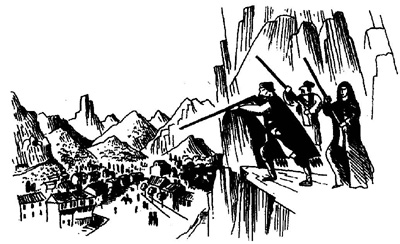
A Night in Montenegro
South of Rijeka the Adriatic Highway with its sometimes amazing views of offshore islands that appear to be swimming one behind the other, like a shoal of sea monsters, extends almost to the Albanian frontier. Now, in late summer, the roadside and the cliffs below it on what had been until recently one of the most beautiful coasts in the entire Mediterranean were littered with the detritus of snacks and picnics and with the shattered and burnt-out shells of motor cars whose occupants, down here on holiday from the Nordic north, had departed this life for what one hopes is a better world.
Along this road, one of the most perilous in the world in high summer, were the official camp sites, surrounded by high wire fences which effectively separated the campers from the local inhabitants, keeping the former in, the latter out. Some of the larger camps were guarded by armed soldiers and spending the night in one of these places I really felt that once more I was in a concentration camp. As on the shores of most other Mediterranean countries it was forbidden to camp anywhere other than in an organized camp site. Given the state of the roadsides it was difficult to see what else the authorities could do. But for the existence of these camps, some of which after months of continuous occupation were themselves in a repulsive condition, there would probably have been large scale outbreaks of typhoid.
Now the season was nearly over. Soon the Highway would be largely deserted, except by long-distance lorries, and the cleaning-up squads would emerge to haul away the wrecks of automobiles, clear away the beer cans, burn the plastic, unblock the drains in the camp sites and replace the shattered lavatories and wash basins. We kept our spirits up by reminding one another that we were on our way to Cetinje in Montenegro where we were going to stay in the Grand Hotel.
The road to Cetinje, the former capital of Montenegro, begins near Kotor, a seaport at the head of the Gulf of the same name, an astonishing inlet of the Adriatic, with the Crna Gora, the Black Mountain from which the country takes its name, rising above it.
The town stands at the foot of the Lovčen, a summit which rises more than 5700 feet above it, and appears to be still intact behind the fortifications built by the Venetians which zigzag up the mountainside from it.
It was only necessary to go into it through the main gate down by the harbour, as we did, to realize that something was seriously wrong with Kotor. Inside the walls, the city was moribund. A great earthquake which had convulsed large portions of the Balkan Peninsula in 1979, had rendered it uninhabitable, doing to Kotor what a succession of invading Saracens, Serbians, Tartars, Hungarians, Bosnians, Venetians, Austrians, French, British, Russians, Austrians again, Montenegrins, Turks (who had unsuccessfully besieged it in 1538 and 1667), other earthquakes, in 1563 and 1667, and an outbreak of plague in 1572, had all failed to do, except temporarily.
Yet in spite of this latest misfortune Kotor, although more than half-dead, was not completely so. A few stubborn inhabitants still lived within its walls, either in deep, dark, labyrinthine streets, from most of which the afternoon sun had long since gone by the time we arrived in them, that is if it ever shone into them at all, or in little squares, some of them still sunlit, in which children played happily, streets and squares in which the houses and palaces, most of them long since converted into tenements, were often either shored up with balks of timber or else had already been gutted and were shells empty of everything except rubble. Its fate, or only hope, perhaps, depending on how one regarded such things, was to become a museum city, although even that seemed improbable, for it gave the impression that even one minor tremor might be enough to demolish it completely. Meanwhile, the bulk of its former inhabitants, hoiked into the twentieth century in this unpleasant fashion, now either lived in caravans or in lightly built, more unattractive but less dangerous modern houses out beyond the walls.
Because of all this it was no longer possible to visit what other travellers describe as the amazing treasury of the twelfth-century cathedral of St Tryphon and see the head of the city’s patron saint, also the patron saint of gardeners, who was born in Phrygia, the son of a gooseherd, and was put to death in Nicaea in about AD 250, a relic which the citizens of Kotor are said to have acquired out of a ship bound for Europe from Asia Minor, together with other assorted relics of other saints, arms, legs, etc., for 300 gold pieces. Nor was it possible to see the great wooden crucifix, with its tormented Christ nailed to it, said to have been given by Baldwin II, the last Latin Emperor of Constantinople, to the widow of a thirteenth-century Serbian king. Perennially hard-up, he also, at about the same time, disposed of the Crown of Thorns, a portion of the True Cross, the baby linen of Jesus, the Lance, the Sponge and the Chain of the Passion, the Rod of Moses and part of the skull of St John the Baptist – to St Louis, Louis IX of France, the most Christian king.
By the time we left Kotor the sun had already gone from the town completely, as it does quite early, leaving it in cold, dark shadow, and dense black clouds hung threateningly over the tops of the surrounding mountains, although, out beyond the inlet on which the city itself is built, the Gulf was still bathed in sunlight.
The main road to Cetinje by way of the Lovčen Pass was a wild one even by Montenegrin standards. It climbed the steep side of the Lovčen, on the summit of which the remains of Petar II Petrović Njegoš, Prince-Bishop of Montenegro, last of a line of prince-bishops who began to reign in 1516 when the previous ruler retired to Venice, are entombed in a remarkable mausoleum designed by the Serbo-Croat sculptor Ivan Mestrović, who died in 1962.
The road to the Pass, lined with ruined forts, climbed through plantations of oak and pine ravaged by fires that had only recently swept the mountainside. It was loosely metalled, full of pot-holes, had twenty-four major hairpin bends on it and was only one vehicle wide, with lay-bys. Its outside edge frequently overhung precipices and at some places gaps in the masonry, as they did in so many places on the Adriatic Highway, showed where vehicles had been driven clean through the protecting walls taking the occupants on what had been, presumably, a spectacular exit to eternity.
Our ascent of it was made more difficult by a large caravan of picturesquely-clad gypsies who were descending it from the Pass in horse-drawn carts, on foot and with numbers of animals running loose along with them; but finally, having emerged from a tunnel that had been driven through one of the outlying spurs of the massif, we reached the Pass, which was literally white with sheep. Here the sky was threatening and a few drops of icy rain fell. Already old women in long, rusty black skirts and white-moustached men wearing little round black pill-box hats and waistcoats and what looked like baggy jodhpur breeches of heavy, brown homespun were urging the flocks and the cattle that had been grazing around the head of the Pass down to the little village of Njeguši in anticipation of the coming storm.
The village was disposed along one side of what Slavs call a polje, a big green meadow that had once formed the bottom of a lake, with dark woods extended down to the edge of it on the far side. Above it loomed the Lovčen, its limestone rocks now a steely grey in the rapidly gathering darkness. This wild spot was the birthplace of Petar II Petrović Njegoš, the future ruler of Montenegro, sometime between 1811 and 1813.
From the village the road wound up past abandoned and roofless houses to another pass, the Krivačko Ždrjelo, at around 4300 feet, on the rim of another enormous polje in which Cetinje stands more than 2000 feet below.
Just below this pass there was an inn, a gostiona, which is the Montenegrin way of spelling gostilna, where we stopped for a drink.
Inside it four men, one of them the proprietor who was in his shirt-sleeves, were drinking the Albanian brandy called XTRA. All were drunk and beginning to be acrimonious. It was not a place to linger. The three customers had their vehicles parked outside, one of which was a large petrol tanker, and when we got up to go one of them, who turned out to be the driver of the tanker, easily identifiable by his overalls, got up, too, clutched one of the lapels of my coat in order to keep himself in an upright position and, swaying backwards and forwards on his feet like some Cornish rocking-stone, announced that he was about to drive his tanker down to Kotor by the road we had just climbed to the Lovčen Pass. How he was proposing to do this and remain alive was a mystery.
By the time we emerged from the gostiona the storm was directly overhead and for an instant a single, blinding flash of lightning turned the grey limestone of the mountain a dazzling white. It was followed by a single, deafening roll of thunder which reverberated among the rocks. Then an apocalyptical wind blew, bending the trees as if they were reeds. Then the heavens opened.
Thanking our lucky stars that tonight we would sleep in a Grand Hotel instead of in the back of a van unconverted for this purpose, which was what we had now been doing on and off for months, we set off downhill through the downpour into what, insofar as we could see anything at all, resembled a crater filled with twisted rocks, narrowly missing a head-on collision with a bus that was groaning up through the hairpin bends on its way to Njeguši, loaded with what we later discovered was part of the day shift of the ‘Obod’ factory in Cetinje which made refrigerators and other electrical appliances, the ‘Košuta’ footwear factory and the ‘Galenika’ factory for processing pharmaceutical preparations, all of whom would have been a serious loss to the economy.
By the time we reached the city it was completely dark and the rain that had been clouting down had given place to a monotonous drizzle; so dark that in a dimly-lit boulevard opposite what had once been the building occupied by the Italian diplomatic mission I ran over and killed a black cat which darted across the road in front of us. However, even this melancholy incident failed to dampen our spirits completely. For we were looking forward to staying the night at the hotel, which was not just any old hotel but the Grand Hotel of Vuko Vuketič, as it used to be known, otherwise known as the Lokanda, one of the last hotels of its kind in the Balkans: the Balkans strictly speaking being the mountains in Bulgaria that extend across the country from the Yugoslav border to the Black Sea: but in the sense in which I interpret it, the one in which it is commonly used, of the Balkan Peninsula, the lands between the Adriatic and the Black Seas.
I had last stayed in it in the 1960s. I remembered it as a rather splendid cream- and yellow-coloured building with a sort of semicircular foyer that was a bit like a Victorian greenhouse. Originally built in 1864, it was the first hotel to be constructed in Cetinje and to it were sent the official and honoured guests of what was then the Montenegrin capital, which even in its heyday never had more than 5000 inhabitants. (Now it had more than 10,000 inhabitants and had several large factories producing, as well as electrical appliances, shoes, pharmaceutical products and white bauxite.) At one time the hotel housed the United States diplomatic mission. Reconstructed in 1900, and enlarged in 1929, it had two restaurants and forty bedrooms. In its remarkable foyer and in other public rooms, all rather dingy when I was last there, tall old men in national costumes with huge white moustaches, some, almost unbelievably, still with Lugers and Mausers and other weapons stuck in their cummerbunds, sat sipping away at their rakijas, their Albanian XTRA brandies and various other strong drinks for hours on end while remembering old blood feuds, an activity which in Montenegro had been raised to an art form. In fact one visitor, the author of the excellent Companion Guide to Jugoslavia, J. A. Cuddon, records one of these Montenegrin mountaineers taking out his pistol and shooting a mad dog in one of the dining rooms.
The hotel stood in what had been a windswept square when I was last there, for although it was already spring down on the Adriatic, 2100 or so feet below, up here at Cetinje, which is invariably snowed up for five months of the year from October until the end of February, there was still snow on the ground.
Now, on this really foul, wet night, we looked forward to the hot baths which could usually be had in it, sometimes to the accompaniment of alarming clanking noises from the plumbing system; to the big drinks, the scalding hot lamb soup we planned on ordering, and the great gobbets of Montenegrin pork, all brought to the table by ancient servitors; and after that to retiring to bed in one of the large and shabby but clean bedrooms. All things I remembered about the hotel with pleasure from my previous visit and of which I had spoken enthusiastically and perhaps too frequently to my fellow traveller. I could even remember the way to it, through little streets lined with lime and black locust trees, the latter a form of acacia.
By the time we reached the square in the centre of the town in which the hotel stood a thick mist had descended on it and as it was ill-lit I got down and set off on foot to look for it, leaving Wanda in the vehicle.
There, at the southern end of the square in which I remembered it as standing, I was confronted with what looked like an enormous pancake but on closer inspection turned out to be a mound of yellowish rubble. There was no sign of the hotel.
‘Excuse me,’ I said to a passer-by who had halted, curious at my interest in a heap of rubble, speaking in Italian, which sometimes serves in these parts of the world. ‘Do you happen to speak Italian?’
‘Yes,’ he said.
‘Can you please tell me the way to the Grand Hotel?’
‘Grand Hotel,’ he said. ‘That is the Grand Hotel,’ pointing at the mound of bricks and plaster.
‘But what happened?’ I asked.
‘It was the earthquake,’ he said. ‘The great earthquake of 1979. It destroyed not only the Grand Hotel. It also damaged and destroyed a large part of the city.’
‘Is there another hotel?’ I asked him, remembering that back in the sixties although the Grand Hotel had been the only one of any consequence in Cetinje, there had been some talk of another hotel, although whether it was built or about to be built I could no longer recall.
‘No,’ he said, ‘there is no other hotel. The Grand Hotel was the only one. Tourists are no longer allowed to stay in the town. In fact there is no longer even a Tourist Office.’
I told Wanda. At first she thought it was funny about the hotel, especially as there had been no loss of life when it collapsed, although there had been elsewhere in the city. Then when she realized that it meant another night in the van and, if the police found us, probably a long drive all the way back to the coast at Budva, where the nearest hotels and camp sites were, her vocabulary was immense.
In spite of the drizzle and the fog it was the hour of the passeggiata in the main street, which although many of its buildings had been badly damaged was either being rebuilt or had already been built in their original, old-fashioned form.
Young, tall, dark and incredibly handsome men, moustache-less and pistol-less, and equally beautiful girls wearing jeans and as upright as if they had been brought up to carry pots and heavy weights on their heads, as they probably had, walked up and down in little bands past the lighted shop fronts of the pleasant, pale-coloured buildings I remembered, talking animatedly, smoking cigarettes like chimneys and eyeing one another. Apart from the two of us there was not a tourist in sight and the Tourist Office, as my informant had already told me, was closed, with a notice in the window to that effect.
We dined well on the sort of huge pieces of pork we would have been offered at the Grand Hotel if only it had remained standing, quantities of bread – there were no vegetables of any kind on offer – a delicious pastry stuffed with figs, a sort of baklava, but softer than the Greek variety, and drank copiously of a robust red wine of the region called Vranač Plavka in an effort to banish the thought of another night in the open, in a restaurant which resembled a brick-lined bier-keller, except that it was on the ground floor. The waiters, who were all well over six feet tall, wore white shirts and black trousers and black waistcoats. Male guests drank oceans of beer straight out of the bottles, spurning glasses; and old men of the sort I remembered with moustaches like racing bicycle handlebars kissed one another before settling down, as I had remembered them doing, to speak nostalgically, according to Wanda who could understand some of what they said, of what had been until quite recently an almost unbelievably violent past.
‘He who revenges himself is blessed,’ was one of the dicta of family life in a country where male children used to have loaded firearms placed in their hands before they could even stand on their two feet, let alone fire them, in order to prepare them to be good Montenegrins, worthy members of the only Balkan State that was never subdued by the Turks. For Montenegro, until the Second World War, was a man’s country in which a woman’s lot was to perform menial tasks such as agriculture, beget as many male children as possible to make up for the constant death roll among the men, and attend the funerals of their lords and masters when they failed to survive a ceta, one of the predatory raids they spent so much of their time either planning or taking part in. The results of such expeditions were subsequently recorded for posterity by guslari, minstrels, many of them blind, who used to accompany their recitals of these bloody doings on the guslar, a one-stringed instrument rather like a lute, made of wood, or clay, or copper, sometimes even of stone. Some of the ballads, which the guslari knew by heart, were anything up to seventy thousand words long and are still recited today in some parts of what is the smallest Yugoslavian republic. Now these feudal practices were ostensibly no more in Cetinje.
After dinner, having ascertained that there was no official camp site in Cetinje and therefore no camping, which put us in a rather difficult position, we drove hurriedly away and hid the van and ourselves with it behind one of the walls of what had been the royal park, outside the Crnojević Monastery, otherwise the Monastery of the Virgin, so named after Ivan Crnojević who built it in 1484. This original monastery, which he surrounded with a moat and heavily fortified, was razed to the ground by the Turks in 1692, again in 1712 and again in 1785. Above it on a hill, when I had last been in Cetinje, there had been a round tower called the Tablja which the Montenegrins used to decorate with the skulls of Turks, emulating by so doing the Turks who built the Celé Kula, the Tower of Skulls, at Niš in Serbia which they decorated with a thousand Serbian skulls, a few of which are still in position. Whether the Tablja was still standing or whether it had fallen a victim to the earthquake it was impossible to say because it was dark, and the following day, with the fog still persisting, we forgot to ask.
What with earthquakes, the Turks who had set fire to it and destroyed it three times, and the Austrians, Italians and Germans, who had each consigned it twice to the flames, it was a wonder that there was anything left of Cetinje at all. One of its proudest possessions, now in the Treasury of the Monastery, is the skull of the Vizier Mahmut-Pasha Busatlija of Shkodër in Albania, one of Montenegro’s greatest enemies and the last Turkish leader to fight his way into Cetinje and destroy it and the Monastery, in 1785, who was killed in a great battle with Petar I Njegoš in 1796.
There, behind the wall, we spent, as we anticipated we would, an awful night, which not even the good red wine of Vranač Plavka we had drunk alleviated. Soon after we arrived some policemen drove up in a car to the Monastery, obviously in search of us, and we only narrowly escaped discovery.
Meanwhile the rain, which had become torrential again, drummed on the tinny roof of the van making sleep impossible. Finally, in the early hours of the morning, when the rain had finally ceased and we had at last succeeded in dropping off, we were besieged by a pack of savage dogs, one of a number of such packs that infested the park and which had already made the night hideous with their barking and fighting. Why they chose to surround our van was a mystery. Perhaps they could smell a salami that we had hanging up in it.




